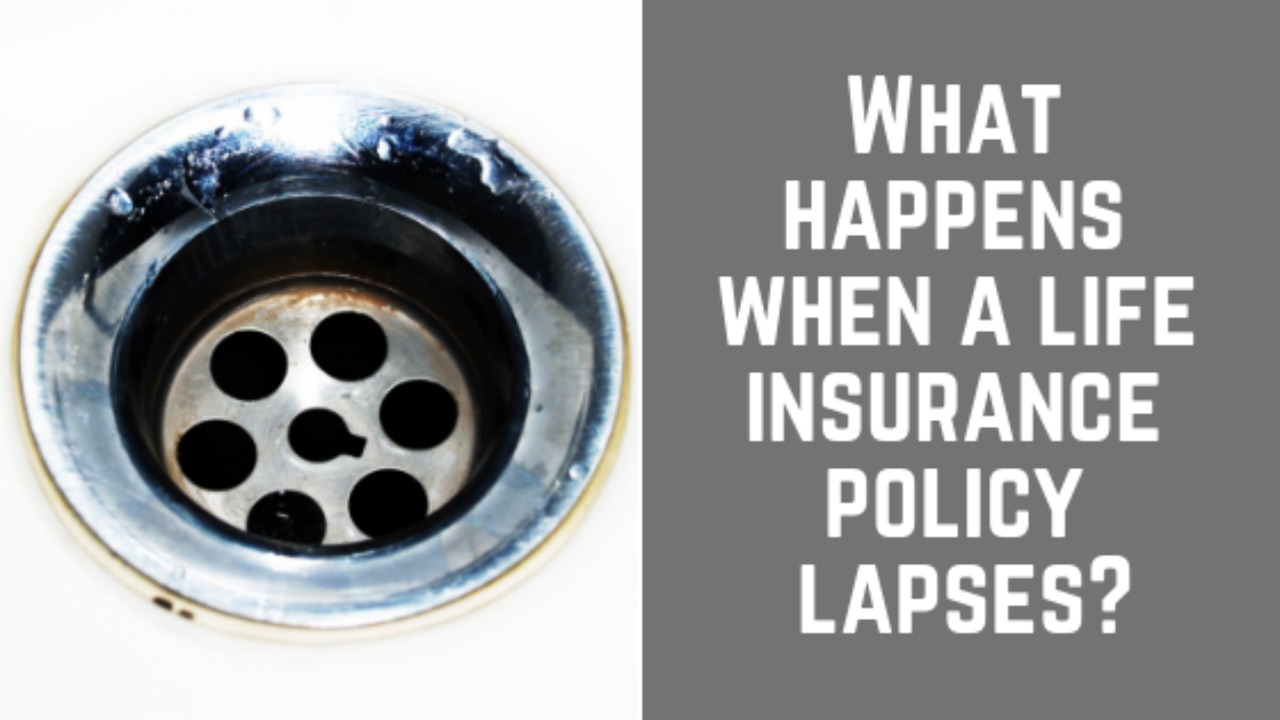

Finance
What Does Lapse Mean In Life Insurance
Published: November 24, 2023
Understanding the meaning of lapse in life insurance and its impact on your financial plans. Get informed and make smart decisions in your finance journey.
(Many of the links in this article redirect to a specific reviewed product. Your purchase of these products through affiliate links helps to generate commission for LiveWell, at no extra cost. Learn more)
Table of Contents
Introduction
Life insurance is a critical financial tool that provides financial security and peace of mind for individuals and their loved ones. It offers a payout to beneficiaries upon the policyholder’s death, helping to alleviate the financial burden in their absence. However, there are instances when life insurance policies can lapse, jeopardizing the coverage and benefits they offer.
In simple terms, a lapse occurs when a life insurance policyholder fails to pay the premium within the specified grace period. When the premium payment is missed, the policy can enter a lapsed state, resulting in the discontinuation of coverage. This lapse can have significant consequences and financial implications for the policyholder and their beneficiaries.
Understanding the causes of a lapse, its consequences, and how to avoid it are essential for anyone with a life insurance policy. In this article, we will delve into the meaning of lapse in life insurance, explore the reasons behind lapses, discuss the consequences, and provide strategies to prevent lapses from occurring. Additionally, we will outline the steps to reinstate a lapsed life insurance policy in case it does happen.
By gaining a thorough understanding of lapses and how to manage them, policyholders can protect their loved ones and ensure the preservation of their financial security. Let’s explore the world of life insurance lapses and learn how to navigate them effectively.
Definition of Lapse in Life Insurance
In the context of life insurance, a lapse refers to the termination or discontinuation of a life insurance policy due to the non-payment of premiums within the specified grace period. When a policy lapses, it means that the coverage and benefits provided by the policy are no longer in effect.
The grace period is a predetermined period of time, typically 30 days, during which the policyholder can make a premium payment without any penalties. If the payment is not made within this grace period, the policy will enter a lapsed state.
When a policy lapses, it can have various implications depending on the type of life insurance policy. In the case of term life insurance, the coverage ends immediately upon the lapse, and the policyholder and beneficiaries no longer have any protection. On the other hand, permanent life insurance policies, such as whole life or universal life insurance, may have some residual benefits even after the lapse, such as the build-up of cash value that can be utilized by the policyholder.
It’s important to note that a lapse in a life insurance policy can occur due to the non-payment of premiums, even if the policy has accumulated a cash value. The cash value can be used to cover premium payments if there is enough value in the policy, but if it is insufficient, the policy may still lapse.
Understanding the definition of a lapse in life insurance is crucial for policyholders to ensure the continuity of their coverage and benefits. By being aware of the consequences of a lapse and the steps to avoid it, policyholders can take proactive measures to maintain their life insurance policy and protect their financial security.
Causes of Lapse in Life Insurance
Lapses in life insurance policies can occur for a variety of reasons. Understanding the common causes of lapses can help policyholders identify and address potential issues, ensuring the continuous protection of their coverage. Here are some of the main causes of lapses in life insurance:
- Non-payment of premiums: The most common cause of a lapse is the failure to pay the required premiums on time. Life insurance premiums must be paid regularly within the specified grace period. If a policyholder misses one or more premium payments and does not make them up within the grace period, the policy will lapse.
- Financial difficulties: Financial hardships can lead to a lapse in life insurance coverage. Unexpected job loss, medical expenses, or other financial challenges can make it difficult for policyholders to maintain premium payments, resulting in a lapse.
- Lack of awareness: Some policyholders may be unaware of the grace period or forget to make premium payments. This lack of awareness or forgetfulness can inadvertently lead to a lapse in the policy’s coverage.
- Policy modifications: Making changes to the life insurance policy, such as reducing coverage or adjusting payment structures, can also cause a lapse. If these modifications are not handled properly or if new premium arrangements are not put into place, the policy may lapse.
- Insufficient funds: Insufficient funds in the policyholder’s bank account can result in failed premium payments. If there are not enough funds to cover the premium amount, the payment will bounce, potentially leading to a lapse in coverage.
- Automatic premium loans: Some life insurance policies have a provision that allows the insurer to automatically borrow against the policy’s cash value to cover missed premium payments. However, if the policy’s cash value is not sufficient or if the policyholder is unaware of this feature, the policy could still lapse.
It is important for policyholders to be aware of these causes of lapses and take proactive measures to prevent them. By staying informed, maintaining financial discipline, and being vigilant about premium payments and policy modifications, policyholders can mitigate the risk of a lapse and ensure the continuous protection of their life insurance coverage.
Consequences of Lapse in Life Insurance
Lapses in life insurance policies can have significant consequences for both the policyholder and their beneficiaries. Understanding these consequences is crucial for policyholders to fully grasp the importance of maintaining their life insurance coverage. Here are the primary consequences of a lapse in a life insurance policy:
- Loss of coverage: The most immediate and obvious consequence of a lapse is the loss of life insurance coverage. Once a policy lapses, the policyholder and their beneficiaries are no longer protected by the policy, leaving them financially vulnerable in the event of the policyholder’s death.
- No death benefit: The death benefit is the payout that the beneficiaries receive upon the policyholder’s death. When a policy lapses, the death benefit is no longer available. This can have severe financial implications, as the beneficiaries will be left without the intended financial support.
- Difficulty in reinstatement: Reinstating a lapsed life insurance policy can be challenging. Depending on the insurance company’s policies and the duration of the lapse, the policyholder may need to undergo a new underwriting process, which could involve medical exams and higher premiums. This can make it more difficult and expensive to reinstate the coverage.
- Loss of accumulated cash value: If the lapsed policy was a permanent life insurance policy, such as whole life or universal life insurance, there may have been a cash value component that was built up over time. A lapse can result in the loss of this accumulated cash value, which could have contributed to the policyholder’s financial goals or served as a source of emergency funds.
- Need for a new policy: In some cases, policyholders may need to apply for a new life insurance policy after a lapse. However, a new policy could come with higher premiums due to changes in the policyholder’s age or health. Additionally, if the policyholder’s health has significantly deteriorated since the initial policy was taken out, it could result in higher premiums or even denial of coverage.
- Emotional and financial stress: A lapse in life insurance coverage can cause significant emotional and financial stress. Knowing that their loved ones will not be financially protected in the event of their death can create anxiety and worry for the policyholder. It can also create financial strain and uncertainty for the beneficiaries, who may now have to bear the financial burden without the intended support.
Understanding the consequences of a lapse in a life insurance policy underscores the importance of timely premium payments and proactive management of the policy. By staying vigilant and taking preventive measures, policyholders can ensure the continuous protection and financial security provided by their life insurance coverage.
Strategies to Avoid Lapse in Life Insurance
Preventing a lapse in life insurance coverage is crucial to maintain financial security for both the policyholder and their beneficiaries. Consider the following strategies to avoid a lapse in your life insurance policy:
- Set reminders for premium payments: Utilize technology or traditional methods to set reminders for premium payments. Whether it’s through calendar alerts, automatic transfers, or post-it notes, ensuring you have a system in place to remind you of premium due dates can help prevent a lapse.
- Review your budget and prioritize premiums: Take a close look at your budget to understand your financial obligations and prioritize life insurance premiums. Cutting back on non-essential expenses or reevaluating your spending habits can free up funds to ensure timely premium payments.
- Choose a payment frequency that suits you: Some policies offer flexible premium payment options, such as quarterly or annual payments, in addition to monthly payments. Consider selecting a payment frequency that aligns with your financial situation and makes it easier to manage and track your premium payments.
- Opt for automatic payments: Setting up automatic premium payments can eliminate the risk of forgetting or missing your premium due date. Contact your insurance provider to see if they offer this option and take advantage of the convenience and peace of mind it provides.
- Explore premium payment flexibility: Inquire with your insurance provider about any available options for premium payment flexibility. Some policies may offer grace periods, premium holidays, or the ability to temporarily reduce premiums during financial hardships.
- Regularly review and update your policy: Life circumstances can change over time, such as getting married, having children, or experiencing a significant increase in income. Regularly reviewing and updating your life insurance policy ensures that it aligns with your current needs and helps avoid any potential coverage gaps.
- Consult with your financial advisor: Seeking guidance from a financial advisor can be invaluable in understanding your life insurance policy and developing a comprehensive financial plan. They can provide expert advice on premium management, policy adjustments, and long-term financial strategies.
- Stay informed about your policy: Familiarize yourself with the terms and conditions of your life insurance policy, including the grace period, premium payment options, and any penalties or consequences for a lapse. Being knowledgeable about your policy will help you make informed decisions and take appropriate action when needed.
By implementing these strategies, policyholders can greatly reduce the risk of a lapse in their life insurance coverage. Taking proactive steps to ensure timely premium payments and staying informed about your policy can contribute to the long-term financial security and protection offered by your life insurance coverage.
Steps to Reinstate a Lapsed Life Insurance Policy
If your life insurance policy has lapsed due to missed premium payments, it may still be possible to reinstate the coverage. The process of reinstatement can vary depending on the insurance company and the duration of the lapse. Here are the general steps to follow in order to reinstate a lapsed life insurance policy:
- Contact your insurance company: Reach out to your insurance company as soon as possible after discovering the lapse. Inform them of your intention to reinstate the policy and inquire about the specific requirements and procedures involved.
- Pay any outstanding premiums: In order to reinstate the policy, you will usually need to pay any outstanding premiums, including any late fees or penalties that may have accrued during the lapse. The insurance company will provide you with the exact amount and payment instructions.
- Provide updated information: Depending on the duration of the lapse, the insurance company may require updated information about your health or any changes in your circumstances since the policy lapsed. This could involve completing a new application or undergoing a medical examination.
- Review the reinstatement policy: Familiarize yourself with the terms and conditions of the reinstatement policy. Some insurance companies may have specific guidelines or limitations for reinstating a lapsed policy, such as a maximum time period for reinstatement or higher premiums.
- Sign any necessary documents: The insurance company may require you to sign certain documents, such as a reinstatement form or a statement acknowledging the lapse and the consequences. Make sure to carefully review and understand the contents of these documents before signing.
- Monitor the status of the reinstatement: Keep in close contact with your insurance company to track the progress of your reinstatement application. Follow up regularly and provide any additional information or documentation that may be requested.
- Ensure continuous premium payments: Once the policy is reinstated, it is essential to maintain timely premium payments to avoid any future lapses. Set up reminders or automatic payments to ensure that you stay current with your premium obligations.
Reinstating a lapsed life insurance policy can be a complex process, and the specific requirements may vary from one insurance company to another. It is recommended to reach out to your insurance company directly for detailed instructions and guidance on reinstatement. Act promptly to initiate the reinstatement process as soon as you become aware of the lapse to increase your chances of successfully reinstating your life insurance coverage.
Conclusion
Maintaining a life insurance policy is essential for protecting the financial security of yourself and your loved ones. A lapse in a life insurance policy can have severe consequences, including the loss of coverage and the potential financial burden on your beneficiaries. However, by understanding the causes of lapses, being aware of the potential consequences, and implementing strategies to prevent lapses, you can safeguard your life insurance coverage and ensure the continuity of its benefits.
Setting up reminders for premium payments, reviewing your budget, and prioritizing premiums are all effective strategies to avoid a lapse. Exploring payment flexibility options, regularly reviewing your policy, and consulting with a financial advisor can also help prevent lapses and ensure that your coverage remains appropriate for your needs.
If your policy does lapse, don’t panic. Contacting your insurance company, paying any outstanding premiums, and providing any necessary updated information are the first steps to reinstate your policy. Stay in close communication with your insurance provider throughout the reinstatement process and make sure to maintain timely premium payments once your coverage is reinstated.
Remember, the purpose of life insurance is to provide financial protection and peace of mind for you and your loved ones. By understanding and actively managing your life insurance policy, you can ensure that your family remains protected and supported, even in the event of the unexpected.














